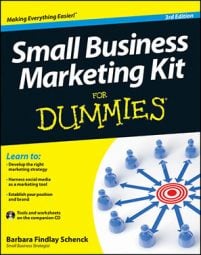Great news for small budget marketers: The most effective small business newsletters look inexpensive, newsy, and current, which translates to the fact that newsletters are among the most economical of marketing materials.
Whether you’re creating printed or digital newsletters, consider the following points:
Stick with a simple format issue after issue. The more your newsletter looks like a highly designed marketing piece, the less it looks newsy.
Feature many short items rather than a few long ones.
Include invitations that require reader response to deepen customer relationships and to help you gauge the effectiveness of your newsletter. For instance, if you announce a new product, offer to provide trial samples on request.
Include valid dates when presenting time-specific offers. Prospects may read printed newsletters in particular well into the future, long after your offer has expired.
Use your newsletter to promote reasons to visit your business or website. For example, a resort might include this item:
Our new online reservation service is off to a great start. More than half of our visitors click to view room photos and floor plans, and 38 percent of those who view our property online make a reservation request. If you haven’t visited our site lately, go to www.ourhotel.com. Be sure to click to enter our web-only sweepstakes for a free weekend stay.
Also, if you’d rather receive our newsletter electronically than by mail, just click the e-newsletter request icon and we’ll transfer your mailing information to our confidential electronic file. Either way, we look forward to sending you quarterly updates, special packages, and resort news.
Combine sales messages with news updates so that readers view your newsletter as more than a promotional mailing. For example:
Rocky Mountain vacations are more popular than they’ve been in years, based on the number of toll-free reservation calls and website visits. Calls in April 2012 were up 22 percent over April 2011, with Thanksgiving and Christmas reservations already ahead of pace. As soon as you know your vacation dates, call us at 1-800-555-5555 or click to make an online reservation so we can reserve your stay.
Prominently feature your business identification and contact information. On printed newsletters, include your logo, phone number, mailing address, e-mail address, and website address on every page of every issue to encourage communications. On digital newsletters, include your street address and phone number so people can follow up in person.
Microsoft Office features a library of free, downloadable templates you can use when producing printed newsletters.
Great tips from a small business newsletter expert
Michael Katz, the founder of Blue Penguin Development, is the guy executives at Constant Contact, one of the biggest names in e-mail marketing, refer to as an e-newsletter legend. Others refer to him as an e-marketing genius. He calls himself a gargantuan, elephantine fan of e-newsletters, for good reason. His Solo Professional E-Newsletter has 6,500 subscribers in more than 40 countries. Here’s his advice for e-newsletter success.
Why e-newsletters work: They keep you in front of clients, prospects, and colleagues and give you a platform for sharing your focus and perspective. Plus, they’re easily forwarded, easily archived, interactive, and cost almost nothing.
What makes an e-newsletter work:
Content matters most. Publishing is easy. Sending content that makes people want to stop what they’re doing is more challenging — and the only way to gain permission to stay in the inbox.
Stay focused. Don’t try to cover lots of topics and involve lots of voices. Keep your focus narrow and write to a specific target audience.
Newsletters only work if you keep sending them. Establish a monthly schedule and commit to a year of publishing so you don’t give into the “four-month itch” — the point at which enthusiasm wanes just before newsletter results start to show.
Mistakes to avoid in your small business newsletter
When writing your small business newsletter, try to avoid these common mistakes:
Don’t write a “Me-Newsletter” full of items about what you’re doing, who you’re working with, and why you’re so wonderful. Give readers useful information, not promotion.
Don’t strip away personality in an attempt to sound professional — and dry and boring. Drop the jargon. Write in the first person. Use a casual voice and tone to talk about things you really believe in.
Information to include: Don’t worry about selling readers. Instead, teach them. Include valuable information, and when there’s a need you can fill, your phone will ring.
Coming up with content: If you know enough to run a business in a given industry, you have a lifetime of content. Those who buy your products and services will always be novices, so use that gap between your expertise and their interest in learning more to guide your content development.
Bottom line: E-newsletters work only if the recipients want to hear what you have to say. Develop a reputation as a source of useful, interesting, unbiased information within your area of expertise and you’ll expand readership and your customer base, too.
For more information, visit Blue Penguin Development to sign up for a free biweekly newsletter, access site resources, and explore a number of e-newsletter assistance program options.

